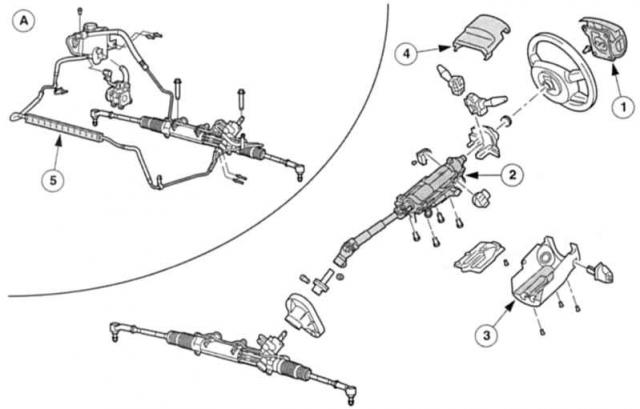Servo support: two gear racks of the steering mechanism with different gears
 |
|
A - Hydraulic oil circulation,
|
3 — the Lower facing of a rack of the steering mechanism,
|
For good dynamic parameters and driving comfort, the Mondeo is responsible for the running gear. Theoretically, in all conceivable driving situations, it should, under various road surfaces and during any movement, strictly coordinate the position of the wheels.
But this is only in theory - in practice, this is nothing more than a compromise, which should correspond as closely as possible to the ideal. Sisyphean labor, which involves industrial powerful computers, the most modern software and - around the globe - countless test transitions in various conditions. Since the wheels of your Mondeo must not only simply «rotate», while driving, they must also – as far as possible unnoticed by you – also perform purposeful up and down movements, as well as changes in direction: even when braking or accelerating, various forces arise that seriously affect the chassis.
And here we need teamwork, when all components are strictly coordinated with each other and suit each other. The chassis includes suspension and damping systems, wheel suspensions of the front and rear axles, steering gear and the wheels themselves with tires. The braking system, which is also an integral part of the running gear, is described in detail in a separate chapter «Brake system».
This delicate matter is the balance of the chassis
Well-designed wheel suspensions, even in the era of computerization, are a rather difficult task: the wheels must constantly be at strictly defined angles to the axis of the car. As soon as your Mondeo crosses, for example, an uneven surface or overcomes a sharp turn, forces inevitably appear that change the geometry of the wheels. At the same time, the wheels should never lose contact with the roadway, otherwise, according to the actions of centrifugal forces, your Mondeo would be off the road along the shortest path. To prevent this from happening, the wheels are shock-absorbed relative to the body: in collaboration with the shock absorbers, the springs «parry» beats, they «unload» road surface. Shock absorbers should be called proper vibration dampers. Since they do not dampen the shocks themselves, but only weaken the natural oscillations of the springs and tires.
Linked to each other – steering and traffic safety
Driving dynamics and road safety, among other things, depend on the fact that the wheels turn confidently in the right direction. This couple should do everything sensitively and purposefully. The nature of the operation of the steering mechanism is also strictly coordinated with the axes and geometry of the steering mechanism.
The running gear of the Mondeo is a good example of the fact that a car of a higher middle class - in terms of comfort and driving safety - does not require big compromises. Front wheels Mondeo «discipline» shock absorber MacPherson struts, the rear wheels work separately - on the rear axle, «baptized» in the Ford Jargon Quadralink. The rear axle works with track correction, which makes the Mondeo a very pleasant car to drive. All rear suspension components are supported by a separate auxiliary frame, which is bolted to the bottom to reduce noise.
| TECHNICAL DICTIONARY | |||
|


Visitor comments